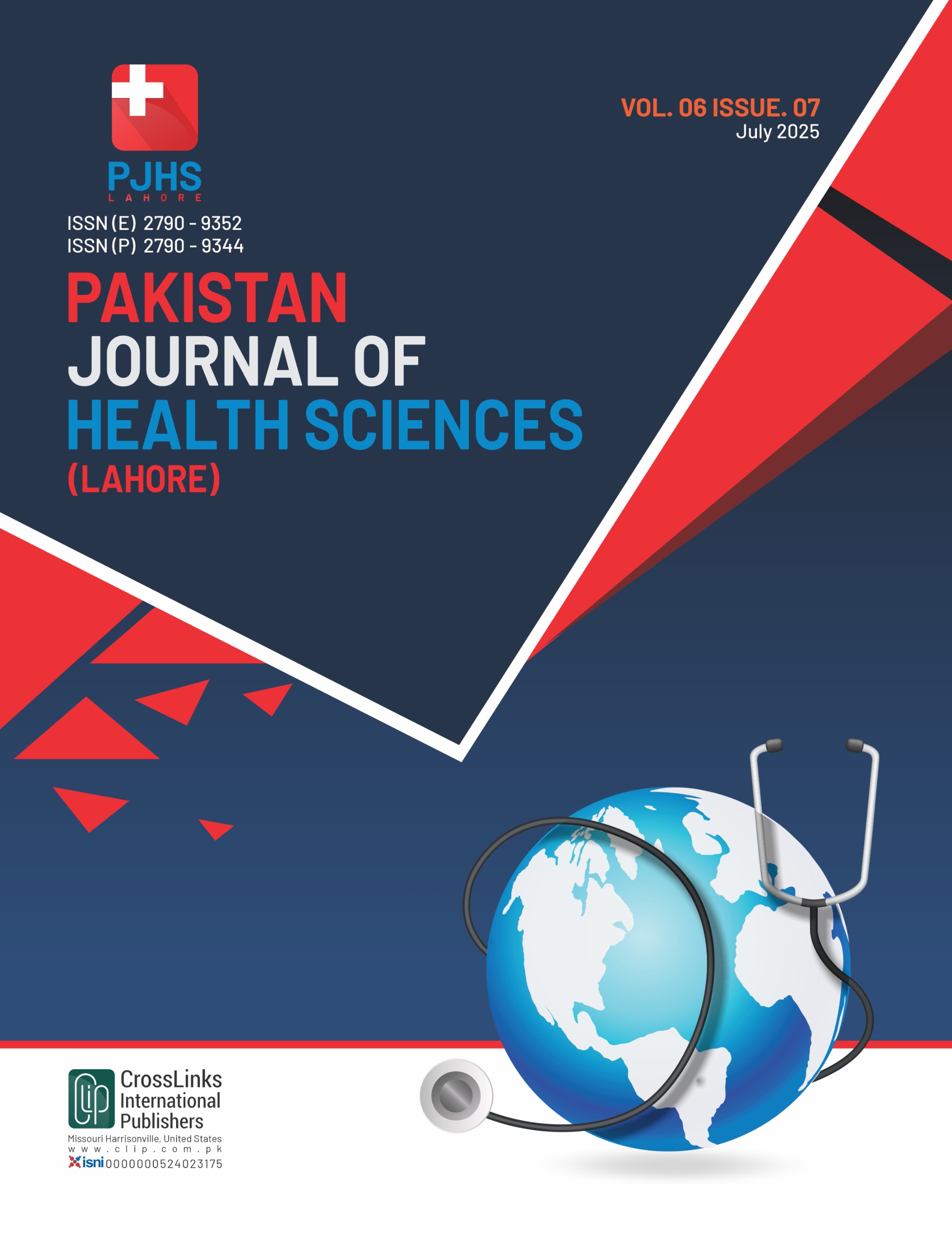Association of Xerostomia with Diabetes a Cross Sectional Study in Subset of Karachi
Xerostomia and Diabetes
DOI:
https://doi.org/10.54393/pjhs.v6i7.3113Keywords:
Xerostomia, Diabetes Mellitus, Salivary Flow Rate, HbA1cAbstract
Xerostomia, is a common oral symptom of Diabetic Mellitus (DM). It has a detrimental impact on clinical procedures and outcomes due to decreased saliva. Considering its impact on oral cavity and dental procedures it is important to identify the Association of xerostomia with diabetes. Objective: To identify the prevalence and association of xerostomia in diabetic patients subset of Karachi. Methods: It was a cross sectional study conducted from January 2024 to October 2024. The calculated sample size was 63 which was increased to 75. Patients reporting to OPD with history of diabetes were recruited and they were advised to get their HbA1c and random blood sugar level (RBS) checked. After getting their HbA1c and RBS reports their stimulated salivary flow rate was calculated. Stimulated salivary flow less than 0.7ml/min was considered as low. Chi square and independent t-test was applied for comparison at 95% confidence interval and p value less than 0.05 was considered as significant. Results: The xerostomia was found to be present in 47 (62.66%) participants.The salivary flow was identified as 0.46 ± 0.31 in diabetic patients with xerostomia, compared to female, male diabetic patients had less salivary flow at 7.01 ± 0.62 HbA1c and 220.53 ± 5.12 RBS. Conclusions: There was 62.66% prevalence in diabetic patients in the recruited subset of Karachi. Males had more prevalence than females. Higher HbA1c and RBS levels were associated with the presence of xerostomia.
References
Ahmad R and Haque M. Oral health messiers: Diabetes mellitus relevance. Diabetes, Metabolic Syndrome and Obesity. 2021 Jul: 3001-15. doi: 10.2147/DMSO.S318972. DOI: https://doi.org/10.2147/DMSO.S318972
Shahbaz M, Kazmi F, Majeed HA, Manzar S, Qureshi FA, Rashid S. Oral manifestations: a reliable indicator for undiagnosed diabetes mellitus patients. European Journal of Dentistry. 2023 Jul; 17(03): 784-9. doi: 10.1055/s-0042-1755553. DOI: https://doi.org/10.1055/s-0042-1755553
Sánchez Garrido I, Ramírez L, Muñoz Corcuera M, Garrido E, Sánchez L, Martínez Acitores ML et al. Xerostomia and Salivary Dysfunction in Patients With Diabetes Mellitus. A Cross‐Sectional Study. Journal of Oral Pathology & Medicine. 2024 Nov; 53(10): 622-36. doi: 10.1111/jop.13583. DOI: https://doi.org/10.1111/jop.13583
Fornari CB, Bergonci D, Stein CB, Agostini BA, Rigo L. Prevalence of xerostomia and its association with systemic diseases and medications in the elderly: a cross-sectional study. Sao Paulo Medical Journal. 2021 Jun; 139(4): 380-7. doi: 10.1590/1516-3180.2020.0616.r3.1902021. DOI: https://doi.org/10.1590/1516-3180.2020.0616.r3.1902021
López-Pintor RM, Ramírez Martínez-Acitores L, Serrano Valle J, González-Serrano J, Casañas E, de Arriba L et al. Xerostomia and hyposalivation. InOral Health and Aging. 2022 Feb; 85-108. doi: 10.1007/978-3-030-85993-0_5. DOI: https://doi.org/10.1007/978-3-030-85993-0_5
Erickson LE and Trump B. Oral and Dental Effects of Xerostomia. InXerostomia 2024 Jun: 51-76. doi: 10.1201/9781003526995-5. DOI: https://doi.org/10.1201/9781003526995-5
Stoopler ET, Villa A, Bindakhil M, Díaz DL, Sollecito TP. Common oral conditions: a review. Journal of the American Medical Association. 2024 Mar; 331(12): 1045-54. doi: 10.1001/jama.2024.0953. DOI: https://doi.org/10.1001/jama.2024.0953
Alakkad T, Fergani O, Abulhamail L, Tajuddin A, Ashy Y, Munshi L et al. The impact of saliva and oral microbiome on restorative dental materials. Journal of Healthcare Sciences. 2023 Dec; 12(3): 752-7. doi: 10.52533/JOHS.2023.31228. DOI: https://doi.org/10.52533/JOHS.2023.31228
Desai JP and Nair RU. Oral health factors related to rapid oral health deterioration among older adults: a narrative review. Journal of Clinical Medicine. 2023 Apr; 12(9): 3202. doi: 10.3390/jcm12093202. DOI: https://doi.org/10.3390/jcm12093202
Abdelaziz AA, Doghish AS, Salah AN, Mansour RM, Moustafa YM, Mageed SS et al. When oral health affects overall health: biofilms, dental infections, and emerging antimicrobial strategies. Infection. 2025 Apr: 1-22. doi: 10.1007/s15010-025-02533-9. DOI: https://doi.org/10.1007/s15010-025-02533-9
Weerasinghe J, Weerasinghe L, Thirugnanasampanthar V, Jayasooriya P, Lombardi T. Cross-Sectional Study on Proportions of Type 2 Diabetic Patients Presenting with Oral Candidal Lesions. Applied Sciences. 2025 May; 15(10): 5539. doi: 10.3390/app15105539. DOI: https://doi.org/10.3390/app15105539
Aprista S, Nelis S, Nasia AA, Prabowo YB. The effect of xerostomia on the quality of life of controlled and uncontrolled type 2 diabetes mellitus patients. Padjadjaran Journal of Dentistry. 2023 Apr; 35(1): 5-9. doi: 10.24198/pjd.vol35no1.41996. DOI: https://doi.org/10.24198/pjd.vol35no1.41996
Fortuna G, Whitmire S, Sullivan K, Alajbeg I, Andabak-Rogulj A, Pedersen AM et al. Impact of medications on salivary flow rate in patients with xerostomia: a retrospective study by the Xeromeds Consortium. Clinical Oral Investigations. 2023 Jan;27(1):235-48. doi: 10.1007/s00784-022-04717-1. DOI: https://doi.org/10.1007/s00784-022-04717-1
Lima DL, Carneiro SD, Barbosa FT, Saintrain MV, Moizan JA, Doucet J. Salivary flow and xerostomia in older patients with type 2 diabetes mellitus. PLOS One. 2017 Aug; 12(8): e0180891. doi: 10.1371/journal.pone.0180891. DOI: https://doi.org/10.1371/journal.pone.0180891
Vasconcelos AC, Soares MS, Almeida PC, Soares TC. Comparative study of the concentration of salivary and blood glucose in type 2 diabetic patients. Journal of Oral Science. 2010; 52(2): 293-8. doi: 10.2334/josnusd.52.293. DOI: https://doi.org/10.2334/josnusd.52.293
Sonpanao P, Janebodin K, Namvichaisirikul N, Thongjit S, Jitprasertwong P. The Prevalence of Xerostomia in Older Thai Individuals with Type II Diabetes Mellitus and Its Association with Type of Toothpaste and Oral Functions: A Cross-Sectional Study Using Questionnaires. Geriatrics. 2023 Jul; 8(4): 76. doi: 10.3390/geriatrics8040076. DOI: https://doi.org/10.3390/geriatrics8040076
Fouani M, Basset CA, Jurjus AR, Leone LG, Tomasello G, Leone A. Salivary gland proteins alterations in the diabetic milieu. Journal of Molecular Histology. 2021 Oct; 52(5): 893-904. doi: 10.1007/s10735-021-09999-5. DOI: https://doi.org/10.1007/s10735-021-09999-5
Adolfsson A, Lenér F, Marklund B, Mossberg K, Çevik‐Aras H. Prevalence of dry mouth in adult patients in primary health care. Acta Odontologica Scandinavica. 2022 Nov; 80(8): 605-10. doi: 10.1080/00016357.2022.2069282. DOI: https://doi.org/10.1080/00016357.2022.2069282
Mascarenhas MK, Cademartori MG, Borges RD, Gonzalez MC, Bielemann RM, Thomson WM et al. Prevalence and Associations of Xerostomia in Older Adults in Southern Brazil. Gerodontology. 2025 Jan. doi: 10.1111/ger.12808. DOI: https://doi.org/10.1111/ger.12808
Ljupka A and Sanja N. The power of saliva in diagnostic oral desease. MEDIS- International Journal of Medical Sciences and Research. 2023 Mar; 2: 13-4. doi: 10.35120/medisij020113l. DOI: https://doi.org/10.35120/medisij020113l
Hassan HA. Exploring the impact of advanced glycation end products on diabetic salivary gland dysfunctions. Glycoconjugate Journal. 2025 Mar:1-0. DOI: https://doi.org/10.1007/s10719-025-10182-1
Hohler AD, Vaou OE, Ho DS. Diabetes and the Autonomic Nervous Systems. InDiabetes and Cardiovascular Disease. 2023 Jun: 577-600. doi: 10.1007/978-3-031-13177-6_19. DOI: https://doi.org/10.1007/978-3-031-13177-6_19
Rahiotis C, Petraki V, Mitrou P. Changes in saliva characteristics and carious status related to metabolic control in patients with type 2 diabetes mellitus. Journal of Dentistry. 2021 May; 108: 103629. doi: 10.1016/j.jdent.2021.103629. DOI: https://doi.org/10.1016/j.jdent.2021.103629
Downloads
Published
How to Cite
Issue
Section
License
Copyright (c) 2025 Pakistan Journal of Health Sciences

This work is licensed under a Creative Commons Attribution 4.0 International License.
This is an open-access journal and all the published articles / items are distributed under the terms of the Creative Commons Attribution License, which permits unrestricted use, distribution, and reproduction in any medium, provided the original author and source are credited. For comments













